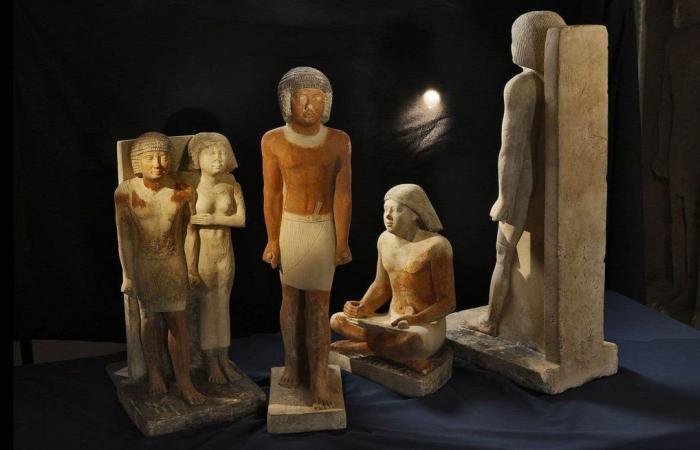Ancient Egyptian scribes enjoyed a privileged status in the society of the time due to their reading and writing skills. However, the repetitive tasks of their work contributed to premature wear and tear on their bodies. Analysis of the bones of scribes buried in the Abusir necropolis between 2700 and 2180 BC has revealed degeneration due to osteoarthritis in various specific areas of their skeletons, degeneration that researchers describe as “risk factors related to their professional activity.”
Petra Brukner Havelková and her colleagues from the Department of Anthropology at the National Museum in Prague and the Czech Institute of Egyptology at Charles University examined and compared the bones of the skeletons of 30 scribes and 39 men of lower social status.
Since the vast majority of traits assessed did not differ between the two groups, the researchers concluded that the control group had a lifestyle that was not physically demanding, and thus similar to that of the scribes. “None of them had done backbreaking work, such as farm labor. They were likely members of the scribe’s family or people in the household who did the housework,” they say.
Scribes were, however, distinguished by a higher incidence of “osteoarthritis and degenerative changes” in specific areas of the skeleton, such as the mandible, cervical vertebrae, shoulder, hand, knee, pelvic bone and foot, which, according to the authors, would result from the professional activity of scribes, which consisted of repetitive tasks in a stationary posture.
To interpret their observations, the researchers relied on texts, relief wall decorations in tombs and statues describing the way in which these officials worked, who were dedicated to writing administrative documents. “They used a fine reed pen in the shape of a brush and wrote on papyrus, pottery shards or wooden boards.”
To accomplish their tasks, they adopted three main postures: the tailor’s position (sitting on the ground, legs crossed), where their skirt served as a writing table; a crouching position, with one leg on the knee and the other bent with the heel on the ground; as well as the standing position. “The position chosen probably depended on the circumstances and the environment in which the scribe carried out his activities, and it is imagined that each individual tended to return to the position he preferred. Even if these positions and the movements performed were not physically demanding, the repetition of the same movements and the holding of these positions for long periods day after day could have affected specific regions of the skeleton,” argue the authors of the study in an article published Thursday in Scientific Reports.
Neck put to the test
One of the regions that appeared significantly more affected in the scribes than in the controls was the spine, particularly the cervical section, behind the neck. “All cervical vertebrae show degeneration, especially osteoarthritis at the apophyseal joints (i.e. between the vertebrae). The C7 cervical vertebra (the lowest), which is located where the lordotic (concave) curve of the cervical spine ends and the kyphosis (convex curve) of the thoracic spine begins, is often one of the most impaired. In the scribes, it shows a huge amount of osteoarthritis compared to the control group, which could result from constant overload on the cervical spine,” the researchers point out.
In the typical working position of the scribe, the head is tilted forward and the spine also bends to accommodate the distance between the eye and the object that is on a horizontal work surface. In this “position which is characteristic of many modern professions, the head finds itself in front of the center of gravity” and the load moment applied to the segment between the cervical vertebra C7 and its neighbor, the dorsal vertebra D1, would be 3.6 times larger than in the neutral position. “Sitting cross-legged in such a position for long periods may have induced increased degeneration of the cervical spine in scribes,” the study authors explain.
The latter also noted a very high prevalence of osteoarthritis in the temporomandibular joint, which connects the lower jaw to the skull. Arthritis in this specific area usually results from dental pathologies, such as teeth grinding or particular eating habits. But its presence among scribes could emanate from their habit of chewing the end of the obliquely cut reed used as a pen in order to give it the shape of a brush. Scribes frequently repeated this action, because “when the pen became frayed or clogged with ink, they would cut off this end that had become unusable and chew the next section.”
Shoulder, thumb, knee
The scribe group also had increased osteoarthritis in the right shoulder, specifically at the head of the humerus (bone between the shoulder and elbow) and the clavicle. This would indicate that the shoulder was subjected to overload when the scribes were in a static sitting position with their arms raised without support, as when typing.
The first metacarpal of the thumb of the right hand was also significantly altered by osteoarthritis, presumably due to pen grip and precise thumb movements, the high frequency and duration of which may have generated long-term mechanical stress.
The presence of osteoarthritis at the lower end of the right femur, where the latter articulates with the patella of the knee – which was probably induced by the repetition of deep knee flexions -, as well as at the level of the neck of the talus of the right foot (tarsal bone which articulates with the tibia) and damage to the left ischial tuberosity (bulge located behind and at the bottom of the pelvic bone, which is a point of support in sitting position) suggest that the scribes preferred the squatting position where the right heel rests on the ground and the left leg is in a kneeling position or in a cross-legged sitting position, indicate Mme Havelková et ses colleges.
According to the latter, all of the regions which were more strongly affected among scribes potentially represent risk factors linked to their professional activity. The fact that the damage in the region of the lower limbs (femur, neck of the talus and pelvic bones) is not very different from those of the control group, however, suggests that the positions adopted by the scribes were common among the population of the Ancient Egyptian Empire, they specify.
The researchers also argue that “the identification of affected regions and particularly their combination could be useful to distinguish individuals who exercised the profession of scribe among the skeletons found whose title would not have been preserved.”






